Community-based organizations are primed and ready to help New Yorkers deal with extreme weather events but say they need more robust communication, engagement, and financial resources from the city.
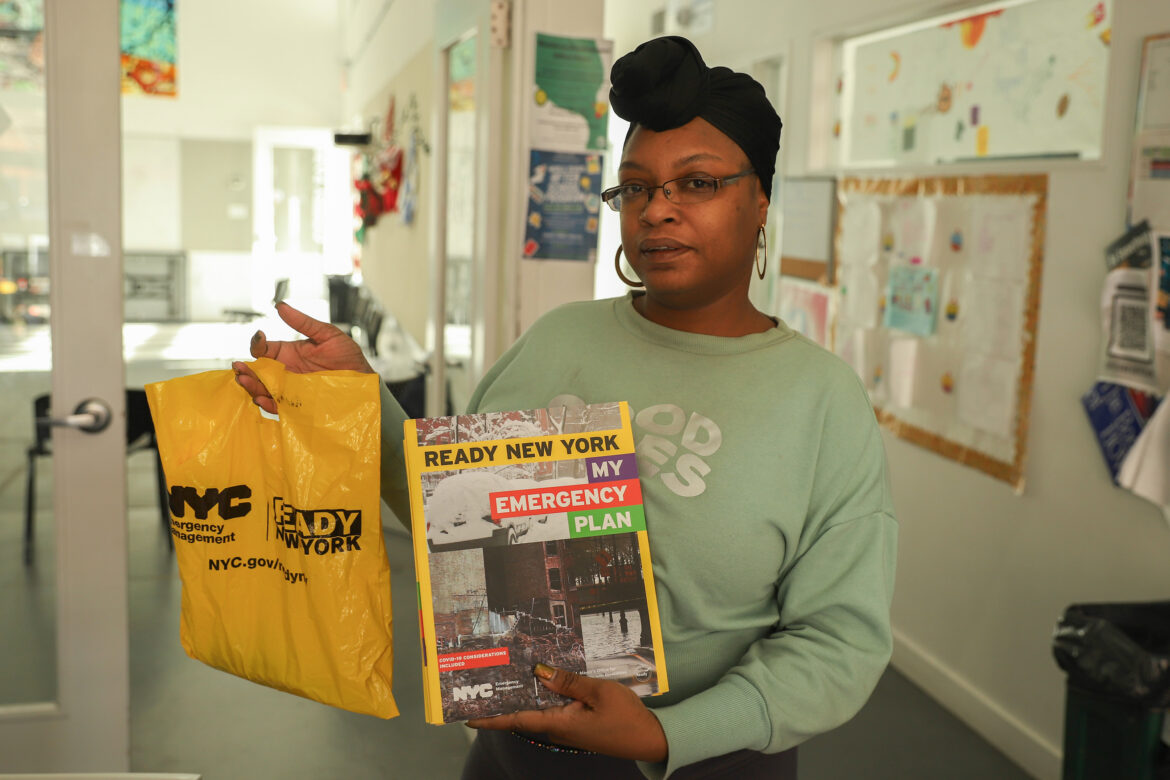
Mary Cunningham
Red Hook Initiative (RHI) Community Organizing Manager Tevina Willis shares some of the emergency preparedness materials RHI hands out to residents.On Sept. 29, Red Hook Initiative (RHI) had been planning to host one of its emergency preparedness events to give away small bags stocked with LED flashlights, first aid kits, and emergency plan materials from the city. But the weather had something else in mind.
A storm rolled in with little notice, drenching the South Brooklyn neighborhood and several other pockets of New York City. Conditions were so bad, RHI Community Organizing Manager Tevina Willis decided to postpone the event. The city also issued a travel advisory, urging New Yorkers to stay off the roads, while the downpour brought numerous subway lines to a halt and flooded hundreds of schools.
“This flooding that happened in September was the worst I’ve seen since Sandy,” Willis said.
At the rescheduled meeting the next week, concern from residents was palpable. Willis polled the room, asking people to write down what would have come in handy during and after the storm via post-it note. The responses—simple things like food, extra water, and flood barriers—would help inform the RHI organizer on how to assist her neighbors the next time.
“That way I know how to utilize the funds in the future to get the community what they need,” said Willis.
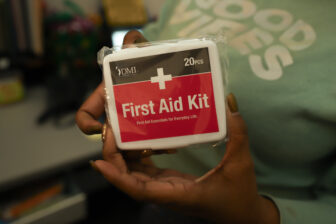
Mary Cunningham
Mini-first aid kits that Red Hook Initiative (RHI) hands out as part of its emergency preparedness materials.As extreme weather events induced by climate change continue to batter New York, advocates say the city isn’t doing enough to prepare residents and keep them safe. Following the air quality crisis last summer, the New York City Office of Emergency Management (NYCEM) came under fire for its laggard response.
The agency got caught in the crosshairs again in September’s heavy rains: While NotifyNYC, NYCEM’s public communications system, messaged people to “move to higher ground,” there were no instructions on where exactly to go.
RELATED READING: ‘Predictable Emergencies’: NYC Flash Floods Spur Renewed Calls for Basement Legalization
Advocates and city officials have since called for reforms and greater accountability. In September, Councilmember Lincoln Restler introduced a package of legislation which would create a public notification plan and emergency response protocol for future air quality crises. The following month, Comptroller Brad Lander launched an investigation into the city’s handling of extreme rainfall, which is still ongoing.
In the meantime, community-based organizations, as the eyes and ears of their neighborhoods, are ready to roll up their sleeves and help. With strong social ties, they are often best suited to know who needs assistance and how to reach them during emergencies. The city has invested in these groups through initiatives like Strengthening Communities, which helps neighborhood networks build emergency response plans with support from NYCEM.
But advocates who spoke with City Limits say they need better communication, meaningful engagement, and steady financial resources from the city to live up to their full potential—especially as extreme weather incidents are expected to increase and intensify in the coming years.
“This is about long-term cultivation of capacity at the street level, and we need it because we’re going to be facing this over and over again,” said Rebecca Bratspies, a CUNY Law professor and director of the school’s Center for Urban Environmental Reform.
Getting the word out
One of the advantages community-based organizations offer is hyper local communication networks. This is one of LES Ready’s secret weapons. The disaster preparedness and recovery group, which like many others formed in the wake of Hurricane Sandy, is made up of 38 organizations in the Lower East Side including settlement houses, healthcare providers and community gardens.
When there’s an impending disaster, LES Ready leverages its network to inform the public. During the flooding event in late September, the organization forwarded information from NYCEM and sent out alerts about free flood protection barriers and water alarms available for pickup at local Councilmember Carlina Rivera’s office.
These came in handy for member organizations in their network that own or manage buildings at risk of flooding. Ayo Harrington, co-chair of LES Ready, said those were some of the main groups that asked for supplies.
It’s especially important to work through the channels that already exist when there’s a disaster, said Jeff Schlegelmilch, director of the National Center for Disaster Preparedness at the Columbia Climate School.
“Community groups are really important conveners and portals,” said Schlegelmilch. “You can’t necessarily expect a utility or an agency to go and knock on the door of everyone in the community.”
But these groups’ notifications are only as effective as the information they receive. Many, like LES Ready, rely on updates from NYCEM to inform their own messaging as well as support from the agency to respond to incoming inquiries about what the city is doing.
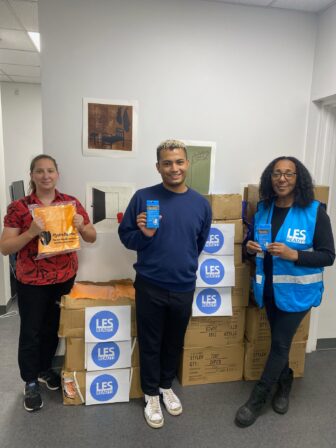
Courtesy of LES Ready
During the Sept. 29 flooding event, LES Ready distributed free flood protection barriers and water alarms to neighbors in need.This issue came to light over the summer at an oversight hearing on the Adams administration’s response to the air quality crisis last June. Councilmembers wanted to know which community groups NYCEM involved to alert the public about the worsening pollution—the result of migranting smoke from wildfires in Canada, which turned the city’s skies a hazy orange.
NYCEM Commissioner Zachary Iscol claimed the agency sends out email notifications to a list of organizations during weather emergencies. However, Victoria Sanders, a research analyst at the NYC Environmental Justice Alliance (NYC-EJA), said that isn’t always the case.
“[During the hearing], they kept bringing up this community based organization network that they have that they reach out to whenever anything’s happening,” said Sanders. “NYC-EJA is deep within the community based organization world. We know most of these people and they weren’t notified.”
City Limits requested a list of the community-based organizations that NYCEM reaches out to during a natural disaster via the Freedom of Information Law. The agency responded saying that a contractor sends the emails and that they cannot share the names of the organizations for privacy reasons.
NYCEM issues communications via NotifyNYC, social media, a biweekly Community Preparedness newsletter that reaches 8,000 subscribers, among other channels.
The NotifyNYC service had more than 1.1 million subscribers in Fiscal Year 2023, according to the Mayor’s Management Report. The messages are available in 12 languages, in addition to English. But with nearly 7 million New Yorkers who don’t receive those alerts, the agency still needs community-based organizations to reach sub-populations like older adults and immigrants.
Above: A breakdown of NotifyNYC subscribers as of December 2023.
Giving community members a seat at the table
Part of the issue with New York City’s disaster preparedness planning, advocates say, is that it is too top down. City officials bring their agenda into communities and expect the people there to follow suit. Instead of simply following NYCEM’s lead, organizations and community leaders want to be brought into the planning process from the start.
A source familiar with NYCEM’s inner workings said they’ve noticed more investment in agency outreach, but that the focus has largely been on education, and less on working hand-in-hand with communities to co-develop disaster response plans.
As a member of the Mayor’s Environmental Justice Advisory Board, Tina Johnson has direct experience working with the city. The NYCHA resident worked on the implementation of the Northern Manhattan Climate Action Plan in her Harlem neighborhood and also serves on the We Act for Environmental Justice membership steering committee.
While she’s proud to serve her community, she said the city can’t always rely on the same people to take up arms. This not only adds pressure to them, but it also discourages wider community involvement. She would like to see the city create more mentorship opportunities and physical spaces for people to come together and participate in the public sphere.
“If you want people to rise to the occasion in an emergency, give them some agency so they can have some dignity in the situation,” she said.
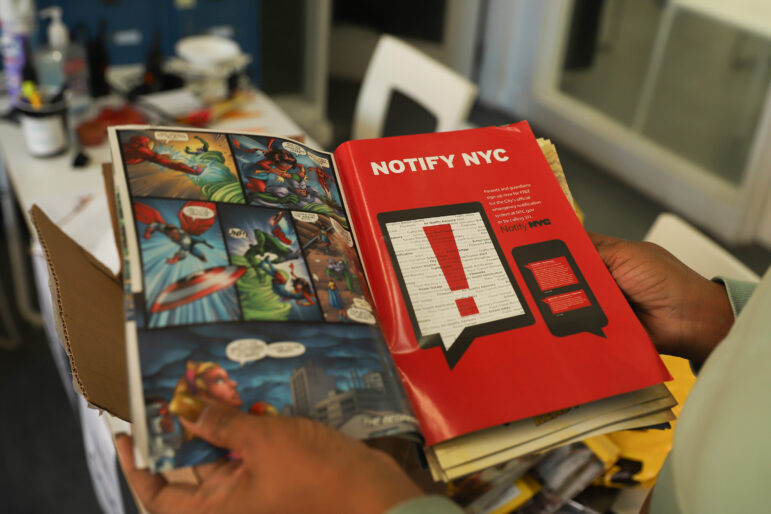
Mary Cunningham.
The city’s emergency plan materials include comic books for kids.In a separate interview, Dariella Rodriguez voiced similar criticisms over the city’s engagement efforts with community groups. Rodriguez works for The POINT CDC in the Bronx.
“I’m gonna be real honest that I feel like many of these processes are very tokenizing and not authentically exploring leadership from organizations,” she said.
“We appreciate the feedback and understand the desire for deeper community integration in our preparedness efforts,” said Aries Dela Cruz, a spokesperson for NYCEM, in a statement responding to this comment.
NYCEM does have dedicated outreach staff that works directly with local organizations across the five boroughs. According to information obtained via Freedom of Information Law, NYCEM budgets $1,562,412 in salaries for community preparedness staff each Fiscal year. Beyond personnel, the agency spent a total of $2,370,080 on community preparedness measures in Fiscal Year 2023, and $1,029,180 in Fiscal Year 2022.
The agency has budgeted $4,220,000 in upcoming Fiscal Year 2025 and $4,755,436 in current Fiscal Year 2024 for community preparedness measures, pending additional grant money awards, according to a spokesperson.
That includes funding for its flagship program Strengthening Communities, in which NYCEM provides grant money, training, and support to a selection of community networks to build emergency response plans and capacity. During extreme weather emergencies, NYCEM leans on the Strengthening Communities members to amplify NotifyNYC messaging.
According to NYCEM, there were 37 community networks in the program in 2023. Participants, which include The POINT CDC, LES Ready, and Red Hook Initiative, are promised $40,000 after they finish building out a comprehensive response plan. Dela Cruz, the NYCEM spokesperson, said the agency is planning a new cohort for this year, but that it hasn’t determined how many community networks there will be yet.
The city spent $423,500 on the program in Fiscal Year 2022, more than $1.7 million in Fiscal 2023 and has received $2 million in federal grant funding for both Fiscal Year 24 and Fiscal Year 25.
Bratspies, the CUNY law professor, expressed skepticism about the program’s level of impact. “It looks great on paper,” she said. “I have heard nothing about it actually happening.”
The Staten Island Community Organizations Active in Disaster (SI COAD) is one of the members of the program. Michelle Bascome, the director of programs and development of Nonprofit Staten Island which oversees the COAD, says their coalition would like to see not just sustained funding after the five-month program ends, but also continued training.
“During the September 29 weather event, we were activated by NYCEM under the Strengthening Communities initiative. They asked us to do digital canvassing and incentivized us to do some call and text blasts,” said Bascome. “We want to be a part of that but the supports that are lacking are the training that could have strengthened our communications plan.”
According to NYCEM, the Strengthening Communities network helped the agency amplify messaging during the Sept. 29 flooding event through social media posts, emails, text blasts and phone calls.
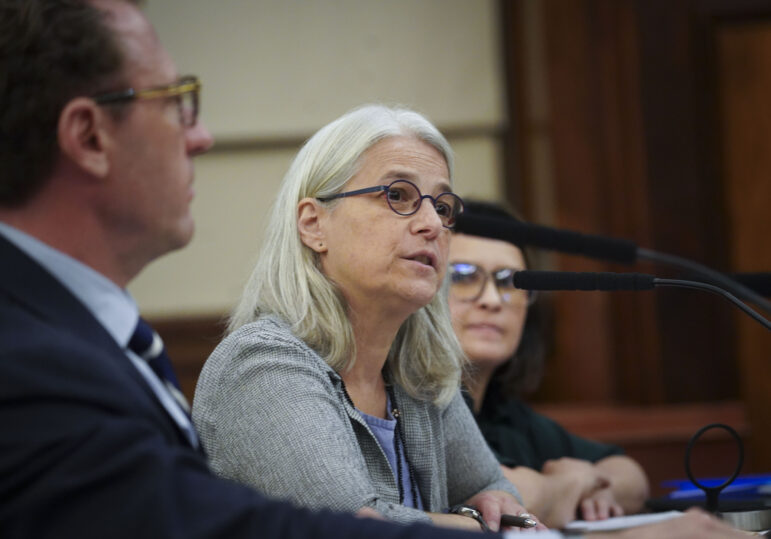
Source: New York City Council/Flickr
On July 12, the NYC City Council held an oversight hearing on the Adam’s administration’s response to the air quality crisis. Left to right: Zachary Iscol, commissioner of NYCEM; Corinne Schiff, JD, deputy commissioner for environmental health at the Department of Health; Beth DeFalco, deputy commissioner for the Department of Environmental Protection.Another, similar city-funded program is Be a Buddy, introduced in 2018 as part of then-Mayor Bill de Blasio’s Cool Neighborhoods program. The joint NYC Department of Health and Mental Hygiene (DOHMH) and the Mayor’s Office of Resiliency effort trained volunteers in three neighborhoods impacted by extreme heat to check on their nearest neighbors, people who were disabled, elderly, or otherwise vulnerable, and provide them with essential services like food and water, health care, and air conditioning.
The POINT CDC ran one leg of the program in the Bronx’s Hunts Point neighborhood where the organization is based. It helped them build bonds and trust with seniors in the community so when a disaster struck, they could easily take action, according to Rodriguez.
“Relationships are the foundation to the communication that is necessary when emergencies happen,” she said.
But initial city funding was in the form of a two-year pilot. While THE POINT was able to cobble together enough grant money with support from the Department of Health to keep Be a Buddy up and running for a few additional years, in 2023, funding dried up completely.
So when the air quality dipped below hazardous levels in June and flooding clogged the streets in September, the community organization couldn’t go knocking on doors or calling residents like it once did. “The resources are not there right now,” said Rodriguez.
But that may be changing soon: a spokesperson for the Health Department told City Limits it will be relaunching Be a Buddy “in the coming months,” but declined to say which community organizations will be included in the next round.
“We are experiencing more extreme heat days due to climate change and the Health Department wants all New Yorkers to be prepared to live with these higher temperatures, especially our neighbors most vulnerable to heat,” the agency said in a statement.
To reach the editor, contact Jeanmarie@citylimits.org
Want to republish this story? Find City Limits’ reprint policy here.








